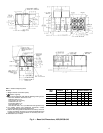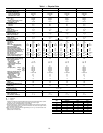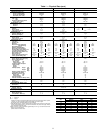
ALTERNATE UNIT SUPPORT — When the preferred curb
or slab mount cannot be used, support unit with sleepers on
perimeter, using unit curb support area. If sleepers cannot be
used, support long sides of unit (refer to Fig. 3-6) with a
minimum number of 4-in. x 4-in. pads spaced as follows:
48EJ,EK,EW,EY024-034 units require 3 pads on each side;
48EJ,EK,EW,EY038-048 units require 4 pads on each side.
Unit may sag if supported by corners only.
Step 2 — Rig and Place Unit — Inspect unit for trans-
portation damage. File any claim with transportation agency.
Do not drop unit; keep upright. Use spreader bars over
unit to prevent sling or cable damage. Level by using unit
frame as a reference; leveling tolerance is shown in Fig. 1
and 2. See Fig. 7 for additional information. Unit operating
weight is shown in Table 1.
NOTE: On retrofit jobs, ductwork may be attached to old
unit instead of roof curb. Be careful not to damage ductwork
when removing old unit. Attach existing ductwork to roof
curb instead of unit.
Four lifting lugs are provided on theunit base rails as shown
in Fig. 7. Refer to rigging instructions on unit.
POSITIONING — Maintain clearance, per Fig. 3-6, around
and above unit to provide minimum distance from combus-
tible materials, proper airflow, and service access.
Do not install unit in an indoor location. Do not locate
unit air inlets near exhaust vents or other sources of con-
taminated air. For proper unit operation, adequate combus-
tion and ventilation air must be provided in accordance with
Section 5.3 (Air for Combustion and Ventilation) of the
National Fuel Gas Code, ANSI Z223.1 (American National
Standards Institute).
Although unit is weatherproof, guard against water from
higher level runoff and overhangs.
Locate mechanical draft system flue assembly at least
4 ft from any opening through which combustion products
could enter the building, and at least 4 ft from any adjacent
building. When unit is located adjacent to public walkways,
flue assembly must be at least 7 ft above grade.
ROOF MOUNT — Check building codes for weight distri-
bution requirements. Unit weight is shown in Table 1.
Step 3 — Field Fabricate Ductwork
48EJ,EK UNITS — Field-fabricated ductwork should be at-
tached to the roof curb. Supply and return duct dimensions
are shown in Fig. 3 and 4. Air distribution is shown in
Fig. 8.
To attach ductwork to roof curb, insert duct approxi-
mately 10 to 11 in. up into roof curb. Connect ductwork to
14-gage roof curb material with sheet metal screws driven
from inside the duct.
Secure all ducts to the building structure, using flexible
duct connectors betweenroof curb and ducts as required. Ducts
passing through an unoccupied space must be insulated and
covered with a vapor barrier. Outlet grilles must not lie
directly below unit discharge. The return duct must have a
90-degree elbow before opening into the building space if
the unit is equipped with power exhaust.
For vertical supply and return units, tools or parts could
drop into ductwork and cause an injury. Install 90 de-
gree elbow turns in the supply and return ductwork be-
tween the unit and the conditioned space. If a 90 degree
elbow cannot be installed, then grilles of sufficient strength
and density should be installed to prevent objects from
falling into the conditioned space.
48EW,EY UNITS — Remove shipping covers from supply
and return air openings. Attach field-supplied ductwork to
unit. Use a single duct over both return openings and a single
duct over both supply openings. See Fig. 5 and 6 for duct
opening dimensions. Secure all ducts to the building struc-
ture. See Fig. 9. Use flexible duct connectors between unit
and ducts as required. Insulate and weatherproof all external
ductwork, joints, and building openings with counter flash-
ing and mastic in accordance with applicable codes.
Ducts passing through an unconditioned space must be
insulated and covered with a vapor barrier.
Install accesssory barometric relief or power exhaust in
the field-fabricated return ductwork. Refer to Position Power
Exhaust/Barometric Relief Damper Hood section on
page 26 for more information.
Instructions continued on page 12.
2


















